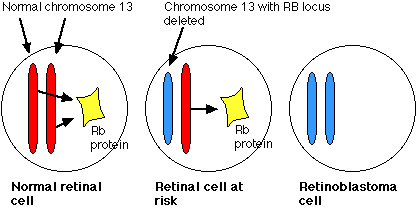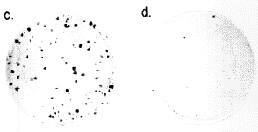| Index to this page |
Familial retinoblastoma occurs when the fetus inherits from one of its parents a chromosome (number 13) that has its RB locus deleted (or otherwise mutated). Then random mutation of the remaining RB locus in any retinal cell removes the inhibition provided by the Rb protein (the Rb protein prevents mitosis by blocking cells from entering S phase of the cell cycle), and the affected cell grows into a tumor. So, in this form of the disease, a germline mutation plus a somatic mutation of the second allele leads to the disease.

In this disease, both inherited RB genes are normal and a single cell must be so unlucky as to suffer a somatic mutation (often a deletion) in both in order to develop into a tumor. Such a double hit is an exceedingly improbable event, and so only rarely will such a tumor occur. (In both forms of the disease, the patient's life can be saved if the tumor(s) is detected soon enough and the affected eye(s) removed.)
The product of the tumor suppressor gene p53 is a protein of 53 kilodaltons (hence the name).
The p53 protein prevents a cell from completing the cell cycle if
These functions make p53 a key player in protecting us against cancer; that is, an important tumor suppressor gene. More than half of all human cancers do, in fact, harbor p53 mutations and have no functioning p53 protein.
Mice have been cured of cancer by treating them with a peptide that turns on production of the p53 protein in the tumor cells. However, there may be an inevitable tradeoff involved: excess production of the p53 protein leads to accelerated aging in mice [Link]. The converse appears also to be true: mice expressing high levels of the anti-aging protein Sirt1 [Link] have their production of p53 depressed and are more susceptible to cancer.
Because tumor suppressor genes are recessive, cells that contain one normal and one mutated gene — that is, are heterozygous — still behave normally.
However, there are several mechanisms which can cause a cell to lose its normal gene and thus be predisposed to develop into a tumor. These may result in a "loss of heterozygosity" or "LOH".
Mechanisms of LOH:
| External Link |
| Animation showing the how mitotic recombination may lead to LOH. |
| Please let me know by e-mail if you find a broken link in my pages.) |
In #2 and #3, the resulting cell now carries two copies of the "bad" gene. This is called "reduction to homozygosity".
| Link to description of the mechanism. |
Genes like RB and p53 are also called anti-oncogenes. They were first given this name because they reverse, at least in cell culture, the action of known oncogenes.

This image (courtesy of Moshe Oren, from Cell 62:671, 1990) shows petri dishes which were seeded with the same number of cells that had been transformed by two oncogenes: myc and ras. Many of those on the left have grown into colonies of cells. However, the cells plated on the right also contained the tumor suppressor p53 gene. Only a few have been able to grow into colonies.
| Link to another illustration of the additive effect of myc and ras. |
The name anti-oncogene may be even more appropriate than originally thought. Both the Rb protein and the p53 protein turn out to complex directly in the cell with an oncogene product of some human papilloma viruses.
Once inside the cells of their host, human papilloma viruses synthesize

Result: E2F is now free to bind to the promoters of genes (like c-myc) that cause the cell to enter the cell cycle (right). Thus this version of E7 is an oncogene product.
The E6 protein of a second human papilloma virus implicated in cervical cancer binds the p53 protein targeting it for destruction by proteasomes and thus removing the block on the host cell's entering the cell cycle.
Although the figure shows the "off" promoters as empty, it is now clear that being "off" involves both| Welcome&Next Search |